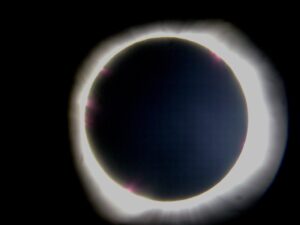
The Goldilocks Principle
The heavens are telling of the glory of God;
And their expanse is declaring the work of His hands. – Psalm 19:1
Another thing we learn from creation – our God is a genius. His genius of design is everywhere we look, in every branch of arts and sciences. The cosmos proclaims, “He designed this–for us!”
The Goldilocks Principle
In astrobiology, the Goldilocks Principle applies to the range of distances that a planet can be from its star and maintain surface temperatures that are just right for water to be liquid. This range is known as the Goldilocks Zone. Temperatures that allow for liquid water are considered “just right” because life as we know it requires water. – National Geographic
I’d like to broaden the scope of the Goldilocks Principle. In everything God did in the six days of Creation, he did it, “just right.”
Not too hot, not too cold–just right.
Not too big, not too small–just right.
Not too hard, not too soft–just right.
And God saw all that He had made, and behold, it was very good. And there was evening and there was morning, the sixth day. – Genesis 1:31
If you know me at all, you know how much I like to brag on the “very good” of God’s creation – His genius in fine tuning the universe. What follows is a small sampling of the things He got just right.
Physics and Astronomy
- As mentioned above, Earth is in the habitable zone for life. If Earth were too close to the Sun, all the water would evaporate. Much further away, and all water would be frozen.
- The axial tilt of the Earth, at 23.5 degrees, gives us seasons and makes more of the Earth habitable.
- The Earth’s magnetosphere, its magnetic field, acts as a forcefield, shielding us from much of the Sun’s ultraviolet radiation.
- The outer planets, especially the gas giants, keep us from being bombarded by asteroids.
- Gravity is just right for us. this animation illustrates the gravitational force of other bodies in the solar system.
- The strong nuclear force and the weak force are balanced precisely to accommodate life.
- The moon gives us tides and stabilizes the climate by keeping the axial tilt relatively stable.
Biology and Nature
- The carbon cycle. Plants and animals provide for each other. Humans and animals breathe oxygen and expel carbon dioxide. Plants breathe in carbon dioxide and give off oxygen. Genius.
 It’s a perfectly balanced equation. Photosynthesis: Sugar and oxygen on one side, carbon dioxide and water on the other.
It’s a perfectly balanced equation. Photosynthesis: Sugar and oxygen on one side, carbon dioxide and water on the other. - The “simple cell.” What a joke. What Darwin dubbed simple is incredibly complex.
- The regulation of blood pressure in a giraffe’s very long neck, keeping it from passing out when it lifts its head.
- The defense mechanism of the bombardier beetle: two reservoirs with two different chemicals which mix when spewed out, burning the predator.
- The Krebs’ cycle.
- Clotting factors
- The eye
- The water cycle – God invented recycling. The water in lakes and oceans evaporates. It collects in the upper atmosphere then waters the earth as rain and snow. Pretty clever, huh?
- DNA – the language of life
Our ability to observe the universe
- There was a school of thought **cough – Carl Sagan – cough** that the Earth was insignificant, placed out in a backwater slum of a nondescript galaxy. but if Earth were closer to the center of the Milky Way, not only would we be subject to dangerous radiation, there would be so much light we couldn’t see the rest of the universe. Where we are, at a distance from the center and kind of between two of the spiral arms, places us perfectly to observe the universe. Chance? I think not.

- The Sun’s diameter is 400 times that of the Moon’s. The Moon is 400 times closer than the Sun. So? So – we have perfect eclipses because, visually, the Moon and the Sun appear the same size.
If these topics pique your interest, here are some references.
Books
Gonzalez and Richards: The Privileged Planet, 2024
Petersen: Unlocking the Mysteries of Creation
Universe: Surveying God’s Created Cosmos
Lisle: Ultimate Proof of Creation
Videos
Incredible Creatures that Defy Evolution
Anything from Spike Psarris




